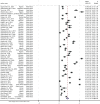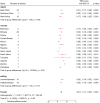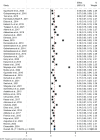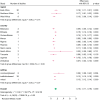Substance use among young people in sub-Saharan Africa: a systematic review and meta-analysis
- PMID: 39323964
- PMCID: PMC11422104
- DOI: 10.3389/fpsyt.2024.1328318
Substance use among young people in sub-Saharan Africa: a systematic review and meta-analysis
Abstract
Background: The use of substances such as alcohol, tobacco, khat, or drugs among young people is becoming a public health concern globally, with particularly high prevalence rates in low and middle-income settings, where socio-cultural and economic factors contribute to distinct challenges in addressing this problem. This review aimed to summarize the current literature on the prevalence of substance use among young people in sub-Saharan Africa (SSA) and identify gaps in the current body of literature.
Methods: Seven databases and Google were searched for studies reporting on substance use prevalence among young people (aged 10-24 years) in SSA, published between January 2010 and May 2024. Observational studies were included, assessed for methodological quality, and checked for the presence of heterogeneity and publication bias using standard methods. A random effect model was used to estimate the pooled proportions for substance use among young people.
Results: The literature search identified 1,889 hits from the databases and Google. Among these 60 eligible studies involving 83,859 respondents were included in the review. The overall lifetime, 12-month, and current prevalence of any substance use among young people in SSA was found to be 21.0% (95% CI= 18.0, 24.0), 18% (95% CI=10,27), and 15% (95% CI=12,18), respectively. Among young people from SSA, alcohol use problem was the most prevalent (40%), followed by khat use (25%), stimulant use (20%), and cigarette smoking (16%). Other substances used by a smaller proportion of young people included cannabis, cocaine, inhalants, sedatives, shisha, hallucinogens, steroids, and mastics. The prevalence of substance use problems was higher among males compared to females, highest in the southern African region followed by Western and Eastern regions, and in community-based studies compared to institutional-based studies.
Conclusions: In SSA, over a fourth of young people use at least one substance in their lifetime, with higher rates among males than females and in community-based compared to institution-based studies. These results emphasize the need for interventions targeting the wider young population and those in specific subgroups identified as being at higher risk of substance use. This approach allows for the provision of tailored support and resources to those who need it most while also promoting positive health outcomes for the entire population of young people in the region.
Systematic review registration: https://www.crd.york.ac.uk/prospero/display_record.php?ID=CRD42022366774, identifier CRD42022366774.
Keywords: alcohol use; drug use; khat use; sub-Saharan Africa; substance use; substance use disorders; substance use problems; young people.
Copyright © 2024 Ebrahim, Adams and Demant.
Conflict of interest statement
The authors declare that the research was conducted in the absence of any commercial or financial relationships that could be construed as a potential conflict of interest.
Figures








References
-
- United Nations . World Programme of Action for Youth to the Year 2000 and Beyond (1995). Available online at: https://undocs.org/A/RES/50/81. (Accessed October 23, 2023).
-
- United Nations Population Fund, U . State of World Population 2023: 8 Billion Lives, Infinite Possibilities - The Case for Rights and Choices. New York: U. N. P. Fund; (2023). Available at: https://www.unfpa.org/sites/default/files/swop23/SWOP2023-ENGLISH-230329....
-
- United Nations . World Population Prospect. New York: P. D. New York: Department of Economic and Social Affairs; (2022). Available at: https://population.un.org/wpp/Download/Standard/Population/.
-
- World Health Organization . Global Accelerated Action for the Health of Adolescents (AA-HA)!: Guidance to support country implementation. Geneva, Switzerland: World Health Organization (WHO; (2017).
Publication types
LinkOut - more resources
Full Text Sources
Research Materials

